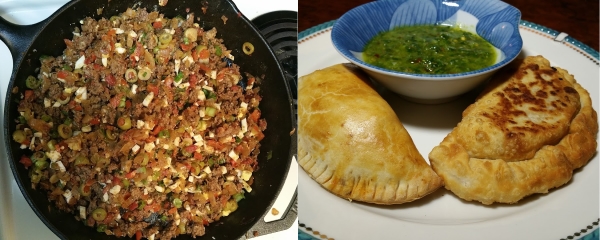
The Participant Observer Recipe of the Month is for Empanadas Mendocinas with Chimichurri. Growing in popularity in the US, empanadas or empanada-like turnovers are found in the cuisine of many cultures. They are relatively easy to prepare, freeze well (before they are cooked), and are a great thing to take to parties. Our recipe is for the Argentinean baked style. Coupled with a concoction of garlic and Italian parsley known as Chimichurri, these savory treats can be eaten as a hearty snack or even a full meal.
There are many types of dishes and foods that seem ubiquitous. Nearly every culture has some sort of stew or soup, and the concept of a tortilla is tremendously widespread, if not universal. The question is whether these styles of food preparation are examples of independent invention or the product of historical cultural diffusion. In the short view of history, empanadas appear to have originated from the place where there name was born, Spain or the Iberian peninsula. However, they appear to have arrived on the culinary scene after considerable contact with the Indian subcontinent, arguing for the possibility that empanadas were derived from Indian samosas. Empanadas are found throughout the Latin world, but in some countries they are better known as panades, pastel and various other similar names. If you travel to Cornwall, England, you are sure to encounter beef, potato and turnip-filled "pasties", which have achieved the status of Protected Geographical Indication in Europe, and are very nearly identical to empanadas. Generically in the US they are known as "turnovers" and not only include savory fillings but are often filled with fruit, like the apple turnover. If you are pressed for time, or in some way averse to rolling pins and dough-making, you can get empanada disks (discos) at Andre's Latin American Market on Morena Blvd.
Most empanadas are deep-fat fried. However, Argentinean empanadas are typically baked instead. If you are trying to cut down on fat, surely the oven-baked method will be kinder to your waistline, but for this recipe of the month we tried both styles and despite the greater caloric burden imposed by deep-fat frying, it was our preference. Baking the empanadas results in a crust that is somewhat cracker-like. Empanadas come in a variety of sizes. Empanadas can be made ahead of time and frozen before they are cooked. You should not thaw them before cooking. If your empanadas are large, they might require cooking at a lower heat for a longer time. Keep in mind that the filling is precooked (with the exception of the scallions and olives), so any method of reheating that browns the crust and heats the filling will suffice. Fillings that have ground beef, onions, peppers, olives (and sometimes raisins) are known as picadillo. South American empanadas, despite their savory fillings, often have sugar added to the dough or are dusted with powdered sugar after cooking. Baked empanadas can be sealed by being crimped with the tines of a fork. If you deep-fat fry them, however, you must make a better seal to prevent the oil from invading the filling, which would be very unfortunate. The edge of an empanadas is known as the repulgue. In numerous places the design created by the repulgue indicates what sort of filling the empanadas have. Empanadas can contain almost any ingredient that you like, including beef, pork, chicken, seafood, onions, peppers, potatoes, hearts of palm - whatever is available and suits your palate. Two ingredients stand out that make South American empanadas unique; raisins and green olives. Some versions have both. The recipe here uses sliced green Manzatta Spanish olives (ours were stuffed with pimentos). When used judiciously the green olives offer a nice bite that balances the meat and onions in the filling. If re-heating already cooked empanadas, it is best to do so in an oven or a toaster oven, as microwaving them softens the crust.
Chimichurri is a sauce that is frequently used in Argentina and Uruguay as a marinade, for basting or as a sauce for grilled meats. It also makes for a wonderful dip for Argentinean empanadas. The ingredients are basic; fresh (Italian) parsley, garlic, oregano, red wine or white vinegar, chili flakes (or chopped fresh chilies) and olive oil. Some cooks add cilantro too. The flavors that stand out the most are the parsley, garlic and chili.
Ingredients (filling):
- 1 pound of ground beef (may substitute other fish or meat)
- 2 cups of chopped onions
- 2 teaspoons cumin
- 1 teaspoon oregano
- 2 tablespoons smoked paprika
- 1 red bell pepper, chopped finely
- 1/2 cup of sliced green olives
- 1/2 cup diced tomatoes (optional)
- 1/2 teaspoon pepper
- 2 teaspoons salt
- 1 teaspoon (or more!) red pepper flakes
- 3 hard-boiled eggs, sliced or chopped
- 1/4 cup olive oil
- 3 scallions, sliced thinly
Ingredients (dough):
- 4 cups of all-purpose flour
- 2 teaspoons baking powder
- 2 teaspoons salt
- 1/2 cup (1 stick) cold butter, cut into small pieces
- 1 cup cold water
- 1 large egg, lightly beaten with 1 tablespoon water (for egg-wash)
Preparation (filling):
- Hard boil 3 large eggs (our favorite method is to place the eggs in a pot of room temperature water, heat the eggs to a full boil, and then cover the pan and wait 20 minutes.
- Measure out and set aside the spices.
- Finely chop the onions and the red bell pepper.
- In a large skillet, lightly brown the ground beef in a 1/4 cup of olive oil.
- Fold in the onions and red bell pepper.
- When the onions are translucent, mix in all the spices and continue to cook for an additional minute.
- Set the filling aside to cool.
- Slice the olives.
- Slice the scallions thinly (both white and green but discard the end roots).
- Chop the eggs rather finely (using an egg slicer first makes it a breeze).
- After the meat mixture has cooled, gently mix in the olives, eggs and scallions.
Preparation (dough):
- Lightly beat 1 egg with 1 tablespoon of water until the yolk and whites are thoroughly mixed (but don't whisk!).
- In a large mixing bowl, combine the flour, baking soda and salt.
- Cut the cold butter into small 1/4-inch chunks.
- Mix the butter into the mixing bowl, distributing it throughout.
- Either press the now flour-covered chunks of butter against the side of the bowl or pinch the butter between your fingers to break it up. The goal is to create little flour-covered pebbles of butter. Using cold butter is essential to this process - the goal is to not let the butter melt.
- Add the cold water to the flour in small amounts and mix into a dough which is a little bit on the dry side but not crumbly.
- Refrigerate the dough for about 30 minutes.
- Divide the dough into 12 equal portions (divide in half, then in 3rds and then each in half once again.
- One by one roll each portion into a ball and then flatten the ball with your hand to make a thick disk.
- Roll the dough out so that you have a 6-7-inch round or until the dough is evenly an 1/8 inch thick.
- Either set aside the rounds (separated by wax paper) or fill each after it is rolled out.
- Scoop up about a 1/2 cup of the filling in a large spoon (or use several small spoonfuls).
- Spoon the filling onto the dough rounds in such a way that the filling is one side of the center-line and thicker in the middle than the ends.
- Brush the egg mixture along the outer edge of the side that has the filling.
If you are baking the empanadas:
- Pre-heat your oven to 400 degrees.
- Fold the dough over the center-line and then press it along the bottom edge.
- With the tines of a fork facing the center of the empanada, gently press the dough along the edge to create a seal.
- Brush the egg wash all over the top of the empanada
- On a parchment-lined baking sheet, bake the empanadas for 25 to 30 minutes or until they are golden brown. Don't crowd the empanadas on the baking sheet. This may mean you have to do two batches.
If you are frying the empanadas:
- Fold the dough over the center-line and then press it along the bottom edge.
- Pinch, fold over and pinch again the edge of the dough (see photo).
- In a deep-fat fryer or a large skillet with about 2 inches of high-temperature oil, fry the empanadas at 350 degrees until they are golden brown.
Chimichurri Ingredients:
- 1 cup (packed) fresh Italian parsley
- 1/2 cup olive oil
- 1/3 cup red or white wine vinegar
- 4 garlic cloves, peeled
- 1 teaspoon dried crushed red pepper
- 1/2 teaspoon ground cumin
- 1/2 teaspoon salt
Note: Pre-made chimichurri can also be purchased at Andre's.
Chimichurri Preparation:
- Rinse and shake dry the parsley.
- Remove the leaves from the parsley stems until you obtain 1 cup (pressed) of leaves.
- Very finely chop the parsley leaves.
- Crush or very finely chop the garlic cloves. (You could also use a food processor for these two steps.)
- In a mixing bowl combine the chopped ingredients, red pepper flakes, oil and vinegar.
Recipe: T. Johnston-O'Neill
Photos: Shari Johnston-O'Neill








